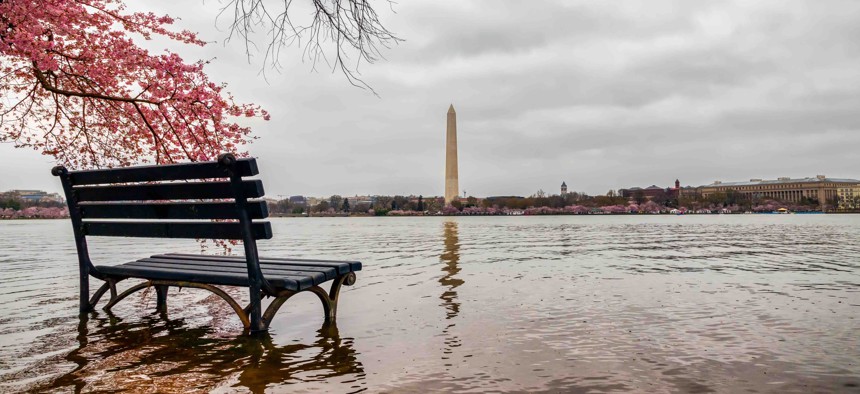A ‘Resilience’ Plan That’s About Much More Than Climate Change

Shutterstock
The District of Columbia’s first ever resilience strategy focuses on areas ranging from flooding to affordable housing.
Increased flood risks are one of the climate-related hazards Washington D.C. faces in the years ahead.
Average high tide levels of the city’s two major rivers—the Potomac and Anacostia—have increased by about 11 inches over the past 90 years and are projected to keep rising in the coming decades. Stronger storms are also expected to become more common.
The city’s first ever “resilience strategy,” released on Monday, makes note of this. The 160-page document includes dozens of initiatives, 68 to be exact, some of which are geared toward directly addressing climate risks like flooding and hotter temperatures.
For example, retrofitting buildings so they’re safer during heatwaves, storms and floods, and pilot projects in two parts of D.C. that will be focused in part on how certain types of infrastructure projects might reduce flood risks while providing other benefits.
In the context of cities, “resilience” is a term often associated with climate change and projects like flood walls, wastewater facility upgrades, and better protecting power utility equipment.
D.C.’s new plan delves into areas that may not immediately spring to mind when resilience is mentioned—issues like the city’s affordable housing shortfall, wealth disparities between black and white residents, educational achievement gaps, and growing cyber threats.
Making transportation faster, cheaper and more convenient, preventing opioid misuse and deaths, and preparing for a future where automation could lead to fewer jobs for those without advanced degrees, are just a few of the other areas that the plan touches upon.
Rashad Young, the District’s city administrator, is responsible for overseeing the implementation of the plan. He says the strategy’s sweeping nature is by design and for good reason.
“If we really just deal with the impacts that are caused by the environmental kinds of issues, then we're really sort of treating the symptom and not effectively tackling the cause,” he said.
Young points out that after natural disasters, such as Hurricane Katrina, which struck New Orleans in 2005, people in poor and disenfranchised communities are often hit hardest and struggle more to recover compared to people who are more well off.
“These events are 10 times worse for those communities,” he said.
Taking on “structural issues,” he says, like those involving housing, income inequality and education, is necessary if the city is serious about improving its ability to withstand natural disasters and other events that deliver blows to residents, like the 35-day federal government shutdown that stretched into January.
D.C. since 2015 has produced about two dozen plans, which are citywide in scope and include hundreds of actions and goals meant to address areas ranging from homelessness to public health. Portions of this earlier work are embedded in the new resilience strategy.
Young calls it an “integrated framework that everybody can focus on, pay attention to and sort of understand what our true north is."
The strategy describes the city’s vulnerabilities in terms of “shocks” and “stresses."
Shocks would include things like floods, earthquakes, mass shootings, cyberattacks or a large local employer shutting down and laying off workers. Whereas stresses are chronic and slow-burning problems, like strained mass transit systems, poverty and troubled schools.
Stresses can “magnify” shocks, the strategy document says.
Initiatives in the plan fall under four categories of goals: “inclusive growth,” “climate action,” a “smarter” D.C., which involves the city navigating advancements with technology, and “safe and healthy Washingtonians,” which deals with public health and crime.
The inclusive growth section of the strategy points out the city is slated to grow to about 987,000 people by 2045, from around 700,000 residents today, and says that the D.C. region’s shortfall of housing units will grow over that time to 690,000 from 575,000.
It also cites statistics from 2013 and 2014 showing the average net worth for black households was $3,500, compared to $284,000 for white households.
Some of the inclusive growth initiatives include items like doubling the number of D.C. youth who graduate from college by 2030, training 1,000 residents to work in the commercial building trades by the same year, and producing 12,000 new units of affordable housing by 2023.
The plan outlines some specific steps for carrying out each initiative. For instance, studying congestion pricing and how revenue from it could be dedicated to new transportation projects and subsidies is a part of an initiative aimed at making transportation across D.C. faster.
One example of an initiative in the climate section is launching a data-driven campaign to reduce what’s known as the “urban heat island effect,” when surfaces like roads, rooftops and other building materials result in higher temperatures within cities.
Another is setting up a “green bank” to extend low-interest loans and other assistance to help property owners with investments in renewable energy systems and efficiency upgrades and other projects, like stormwater management improvements.
Mayor Muriel Bowser’s fiscal year 2020 budget proposal calls for investments aligned with aspects of the plan, like affordable housing funding and spending on a computer model that would help the city better understand how water flows through the District and its sewers.
D.C. developed the strategy with support from 100 Resilient Cities, an initiative that the Rockefeller Foundation said earlier this month it was ramping down. Young said he didn’t think the change would create difficulties for the District’s work going forward.
He added that his understanding is that the foundation is still interested in looking at how it can help cities with the implementation of resilience-related initiatives and said the network between cities that participated in the program remains intact.
The District's resilience strategy can be found here.
Bill Lucia is a Senior Reporter for Route Fifty and is based in Olympia, Washington.
NEXT STORY: Massachusetts District Attorneys Want to Keep ICE From Courthouses






